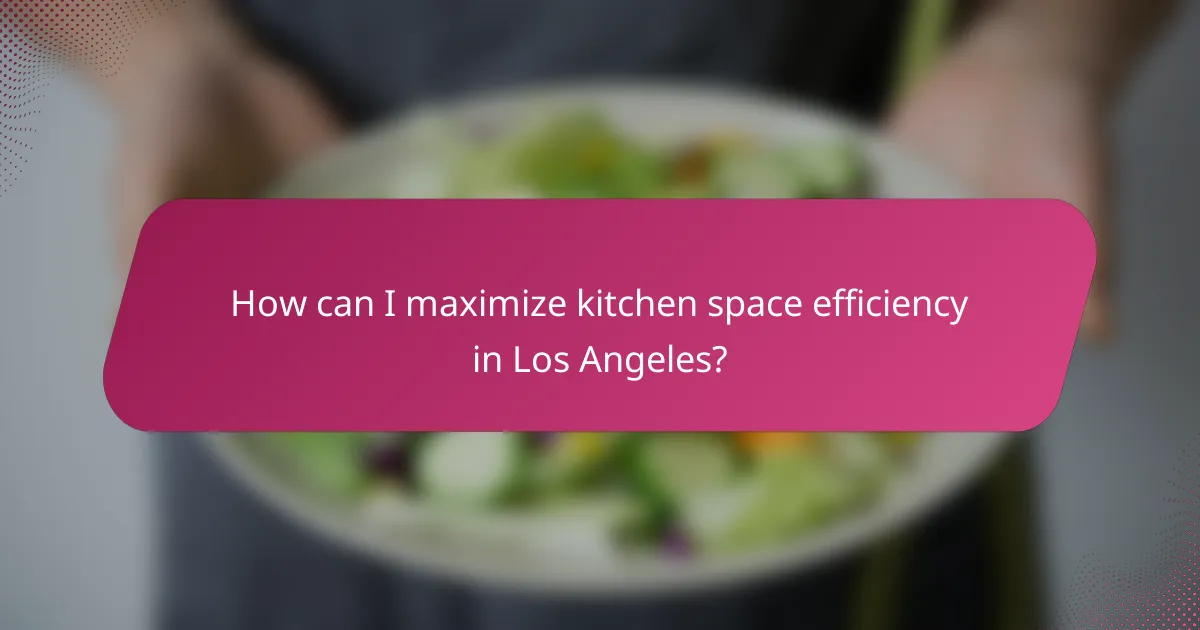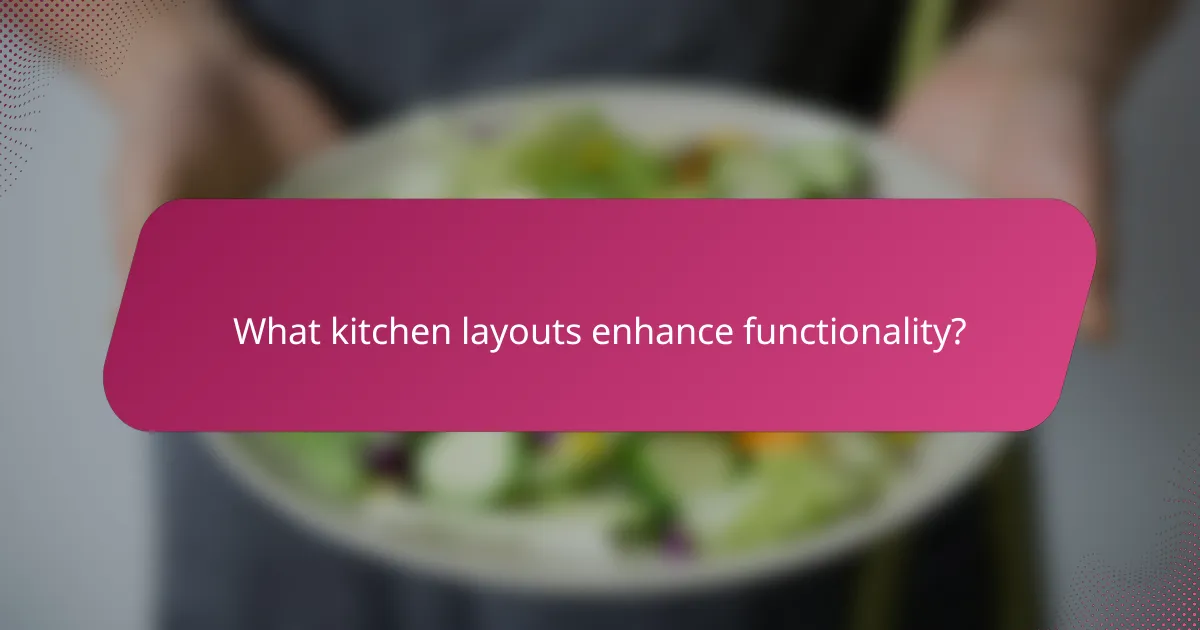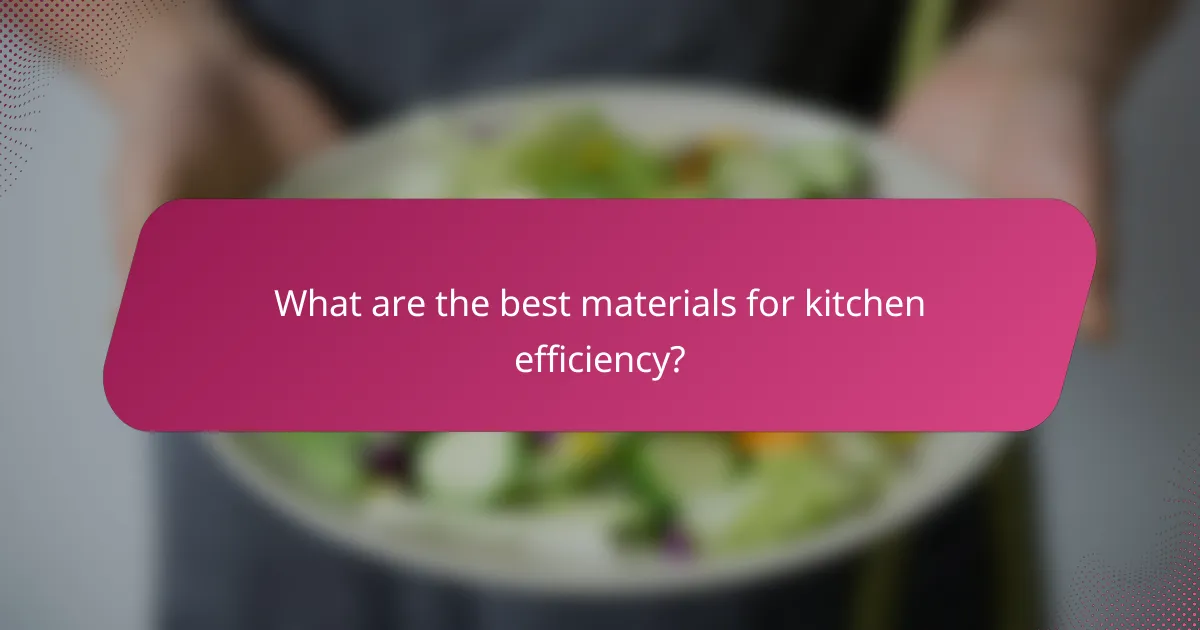Creating an efficient kitchen layout is essential for maximizing space, enhancing functionality, and ensuring a smooth workflow. By employing strategies such as an open design, multi-functional furniture, and smart storage solutions, you can optimize even the smallest kitchens. Understanding the unique advantages of various layouts, like U-shaped or island designs, will further improve usability and flow, making your cooking experience more enjoyable.

How can I maximize kitchen space efficiency in Los Angeles?
To maximize kitchen space efficiency in Los Angeles, focus on creating an open layout, utilizing multi-functional furniture, and incorporating smart storage solutions. These strategies will help you make the most of your kitchen’s limited space while enhancing functionality and flow.
Open-concept designs
Open-concept designs remove barriers between the kitchen and adjacent living areas, creating a sense of spaciousness. This layout encourages interaction and makes the kitchen feel larger, which is particularly beneficial in smaller Los Angeles homes.
Consider integrating an island that serves as both a cooking and dining area. This not only maximizes space but also enhances the kitchen’s functionality by providing additional prep and storage areas.
Multi-functional furniture
Multi-functional furniture can significantly enhance space efficiency in your kitchen. Look for tables that can expand for dining or fold away when not in use, and stools that can double as storage units.
Incorporating a kitchen cart can also be a smart choice, as it provides extra counter space and can be moved as needed. This flexibility is essential in a bustling kitchen environment.
Vertical storage solutions
Vertical storage solutions help utilize wall space effectively, which is crucial in compact kitchens. Install shelves or cabinets that reach up to the ceiling to store items you use less frequently.
Consider using pegboards or magnetic strips for utensils and pots, keeping them within easy reach while freeing up counter space. This approach not only organizes your kitchen but also adds a stylish element to the decor.
Compact appliances
Choosing compact appliances is vital for maximizing kitchen space. Look for models that are designed for smaller areas, such as slim refrigerators, under-counter dishwashers, and combination microwave-ovens.
Energy-efficient appliances can also save on utility bills, which is beneficial in Los Angeles where energy costs can be high. Prioritize appliances that fit your cooking style while conserving space.
Smart organization systems
Implementing smart organization systems can streamline your kitchen workflow. Use drawer dividers and pull-out shelves to keep utensils and ingredients easily accessible, reducing clutter.
Consider labeling containers and using clear bins to quickly identify contents. This not only saves time but also helps maintain an orderly kitchen environment, making cooking more enjoyable.

What kitchen layouts enhance functionality?
Kitchen layouts that enhance functionality focus on maximizing space efficiency, improving workflow, and facilitating movement. The most effective designs include U-shaped, L-shaped, galley, and island layouts, each offering unique advantages based on kitchen size and user needs.
U-shaped kitchen layout
The U-shaped kitchen layout features three walls of cabinetry and appliances, creating a U shape that promotes an efficient workflow. This design is ideal for larger spaces, allowing multiple cooks to work simultaneously without crowding.
Key considerations include ensuring adequate counter space and maintaining a clear path between the sink, stove, and refrigerator, often referred to as the kitchen work triangle. This layout can also incorporate an island for additional storage and prep space.
L-shaped kitchen layout
The L-shaped kitchen layout consists of two adjoining walls, forming an L shape that maximizes corner space and provides an open feel. This design is suitable for medium to large kitchens and encourages social interaction by allowing for an open floor plan.
To enhance functionality, consider adding an island or a peninsula to increase counter space and storage. Ensure that the layout allows for easy movement between the main work areas, maintaining an efficient workflow.
Galley kitchen layout
The galley kitchen layout features two parallel walls with a narrow passage in between, making it highly efficient for cooking and meal prep. This design is particularly effective in smaller spaces, as it maximizes every inch of available area.
When designing a galley kitchen, focus on optimizing storage solutions and utilizing vertical space. Incorporating open shelving or cabinets that reach the ceiling can help keep the area organized and functional.
Island kitchen layout
An island kitchen layout includes a central island that serves as a multifunctional workspace, often incorporating cooking, prep, and dining areas. This design is popular in larger kitchens, as it enhances flow and provides additional storage options.
To maximize the benefits of an island layout, ensure that there is sufficient clearance around the island for easy movement. Consider adding seating to the island to create a casual dining space and encourage social interaction while cooking.

How does kitchen flow impact usability?
Kitchen flow significantly affects usability by determining how easily users can move between key areas while cooking and preparing meals. A well-planned flow enhances efficiency and reduces unnecessary steps, making the kitchen more functional and enjoyable to use.
Work triangle concept
The work triangle concept is a design principle that optimizes the distance between the three main work areas in a kitchen: the stove, sink, and refrigerator. Ideally, these points should form a triangle with each side measuring between 4 to 9 feet to ensure easy access without obstruction.
When designing your kitchen, consider the layout that minimizes movement between these areas. For instance, placing the sink near the stove can streamline cooking and cleaning processes. Avoid placing these elements too far apart, as it can lead to inefficiencies and frustration during meal preparation.
Clear pathways
Clear pathways in a kitchen are essential for smooth movement and safety. Aim for at least 36 inches of clearance between counters and appliances to allow multiple users to navigate comfortably. This space helps prevent collisions and ensures that everyone can work efficiently.
Incorporate open layouts or strategically placed islands to enhance flow. Be mindful of potential obstructions, such as cabinet doors or appliances that may block pathways. Regularly assess your kitchen layout to maintain clear access, especially during busy cooking times.
Zone-based organization
Zone-based organization involves grouping kitchen activities and tools according to their functions, such as cooking, prep, and cleaning zones. This approach enhances efficiency by keeping related items close together, reducing the time spent searching for tools and ingredients.
For example, place pots, pans, and utensils near the stove, while storing cutting boards and knives in the prep zone. Consider dedicating a specific area for baking supplies if you frequently bake. This organization method not only improves flow but also makes it easier to maintain a tidy kitchen.

What are the best materials for kitchen efficiency?
The best materials for kitchen efficiency enhance functionality, durability, and ease of maintenance. Selecting the right materials can significantly improve workflow, reduce energy consumption, and ensure longevity in your kitchen space.
Quartz countertops
Quartz countertops are a popular choice for their durability and low maintenance. They are non-porous, which means they resist staining and do not require sealing like natural stone options. This makes them ideal for busy kitchens where spills and messes are common.
When choosing quartz, consider thickness and color options that complement your kitchen design. Thicker slabs can provide a more substantial look and feel, while lighter colors can make a space appear larger and brighter.
Energy-efficient appliances
Energy-efficient appliances are essential for reducing energy costs and minimizing environmental impact. Look for appliances with the ENERGY STAR label, which indicates they meet strict efficiency guidelines set by the U.S. Environmental Protection Agency.
Investing in energy-efficient models can lead to savings of up to 30% on energy bills compared to standard appliances. Prioritize appliances that suit your cooking habits, such as induction cooktops or smart refrigerators, to maximize efficiency.
Durable flooring options
Durable flooring options, such as tile, vinyl, or laminate, are crucial for maintaining a functional kitchen. These materials can withstand heavy foot traffic, spills, and scratches, ensuring longevity and ease of cleaning.
When selecting flooring, consider slip resistance and ease of maintenance. For example, textured tiles offer better grip, while luxury vinyl planks provide a wood-like appearance with added durability. Aim for materials that balance aesthetics with practicality to enhance your kitchen’s efficiency.


